 | ÐлекÑÑоннÑй компоненÑ: IRF3710S | СкаÑаÑÑ:  PDF PDF  ZIP ZIP |
Äîêóìåíòàöèÿ è îïèñàíèÿ www.docs.chipfind.ru
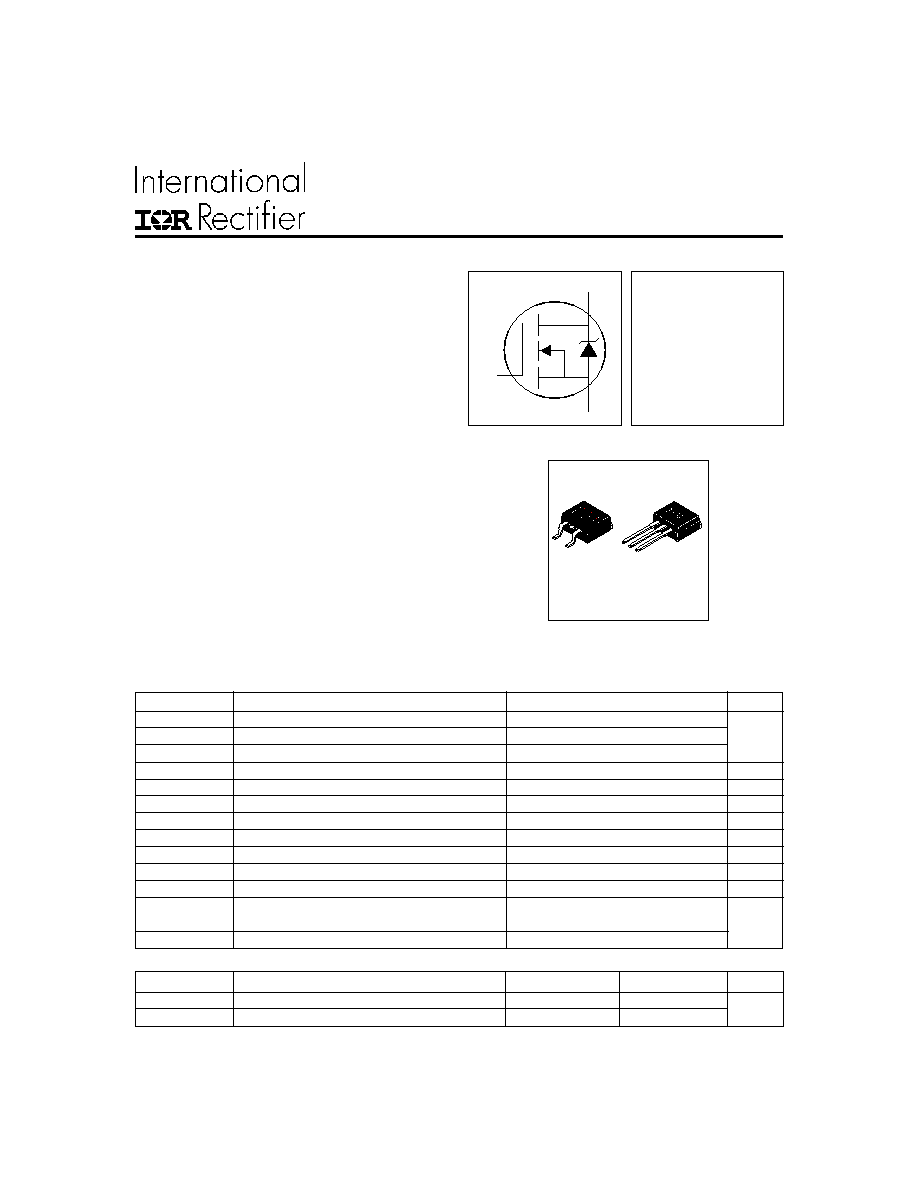
IRF3710S/L
HEXFET
®
Power MOSFET
PD -91310C
Fifth Generation HEXFETs from International Rectifier
utilize advanced processing techniques to achieve
extremely low on-resistance per silicon area. This
benefit, combined with the fast switching speed and
ruggedized device design that HEXFET Power MOSFETs
are well known for, provides the designer with an extremely
efficient and reliable device for use in a wide variety of
applications.
The D
2
Pak is a surface mount power package capable of
accommodating die sizes up to HEX-4. It provides the
highest power capability and the lowest possible on-
resistance in any existing surface mount package. The
D
2
Pak is suitable for high current applications because of
its low internal connection resistance and can dissipate up
to 2.0W in a typical surface mount application.
The through-hole version (IRF3710L) is available for low-
profile applications.
S
D
G
V
DSS
= 100V
R
DS(on)
= 0.025
I
D
= 57A
Description
5/13/98
Parameter
Typ.
Max.
Units
R
JC
Junction-to-Case
0.75
R
JA
Junction-to-Ambient ( PCB Mounted,steady-state)**
40
Thermal Resistance
°C/W
Parameter
Max.
Units
I
D
@ T
C
= 25°C
Continuous Drain Current, V
GS
@ 10V
57
I
D
@ T
C
= 100°C
Continuous Drain Current, V
GS
@ 10V
40
A
I
DM
Pulsed Drain Current
180
P
D
@T
A
= 25°C
Power Dissipation
3.8
W
P
D
@T
C
= 25°C
Power Dissipation
200
W
Linear Derating Factor
1.3
W/°C
V
GS
Gate-to-Source Voltage
± 20
V
E
AS
Single Pulse Avalanche Energy
530
mJ
I
AR
Avalanche Current
28
A
E
AR
Repetitive Avalanche Energy
20
mJ
dv/dt
Peak Diode Recovery dv/dt
5.0
V/ns
T
J
Operating Junction and
-55 to + 175
T
STG
Storage Temperature Range
Soldering Temperature, for 10 seconds
300 (1.6mm from case )
°C
Absolute Maximum Ratings
l
Advanced Process Technology
l
Surface Mount (IRF3710S)
l
Low-profile through-hole (IRF3710L)
l
175°C Operating Temperature
l
Fast Switching
l
Fully Avalanche Rated
2
D P ak
T O -26 2
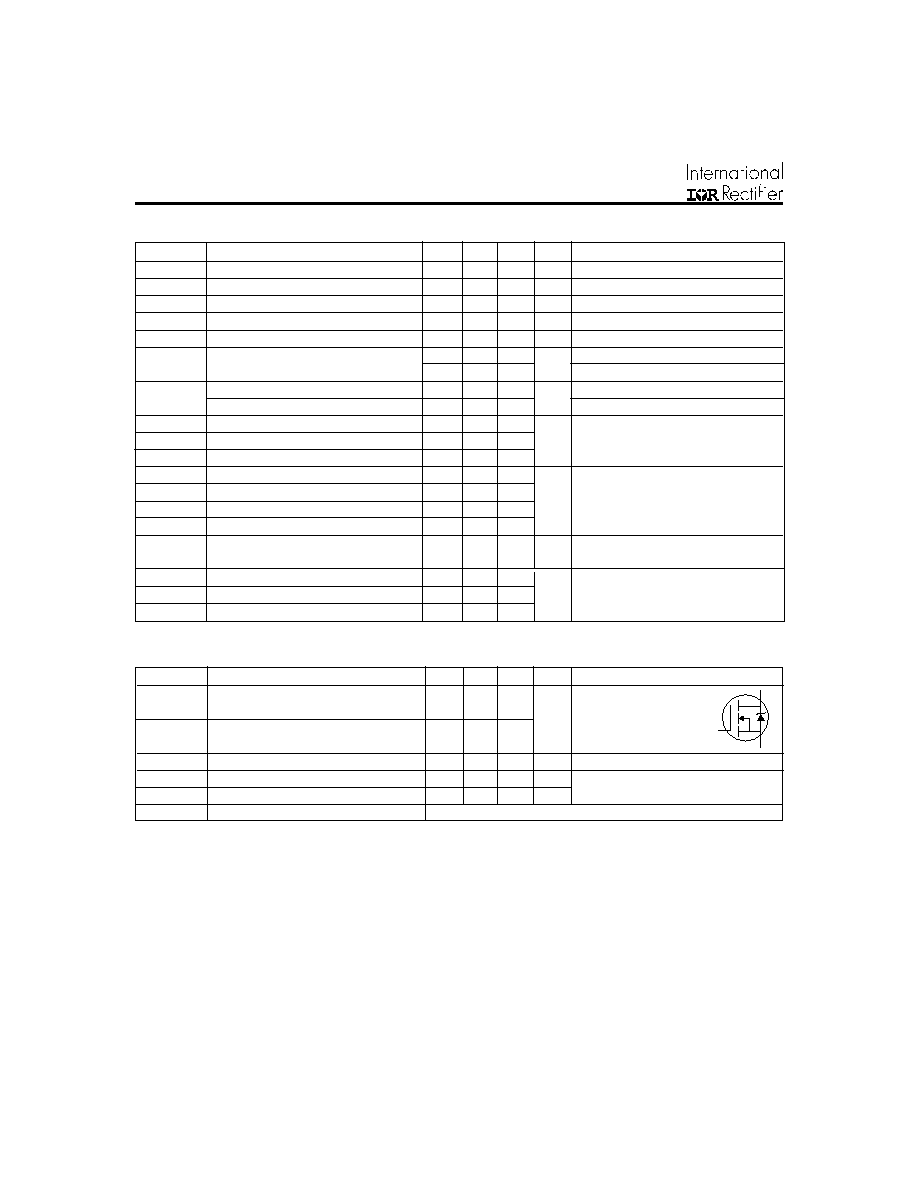
IRF3710S/L
Parameter
Min. Typ. Max. Units
Conditions
V
(BR)DSS
Drain-to-Source Breakdown Voltage
100
V
V
GS
= 0V, I
D
= 250µA
V
(BR)DSS
/
T
J
Breakdown Voltage Temp. Coefficient
0.12
V/°C
Reference to 25°C, I
D
= 1mA
R
DS(on)
Static Drain-to-Source On-Resistance
0.025
V
GS
= 10V, I
D
= 28A
V
GS(th)
Gate Threshold Voltage
2.0
4.0
V
V
DS
= V
GS
, I
D
= 250µA
g
fs
Forward Transconductance
20
S
V
DS
= 25V, I
D
= 28A
25
µA
V
DS
= 100V, V
GS
= 0V
250
V
DS
= 80V, V
GS
= 0V, T
J
= 150°C
Gate-to-Source Forward Leakage
100
V
GS
= 20V
Gate-to-Source Reverse Leakage
-100
nA
V
GS
= -20V
Q
g
Total Gate Charge
190
I
D
= 28A
Q
gs
Gate-to-Source Charge
26
nC
V
DS
= 80V
Q
gd
Gate-to-Drain ("Miller") Charge
82
V
GS
= 10V, See Fig. 6 and 13
t
d(on)
Turn-On Delay Time
14
V
DD
= 50V
t
r
Rise Time
59
I
D
= 28A
t
d(off)
Turn-Off Delay Time
58
R
G
= 2.5
t
f
Fall Time
48
R
D
= 1.7
,
See Fig. 10
Between lead,
and center of die contact
C
iss
Input Capacitance
3000
V
GS
= 0V
C
oss
Output Capacitance
640
pF
V
DS
= 25V
C
rss
Reverse Transfer Capacitance
330
= 1.0MHz, See Fig. 5
Electrical Characteristics @ T
J
= 25°C (unless otherwise specified)
I
GSS
ns
I
DSS
Drain-to-Source Leakage Current
nH
7.5
L
S
Internal Source Inductance
V
DD
= 25V, starting T
J
= 25°C, L = 1.4mH
R
G
= 25
, I
AS
= 28A. (See Figure 12)
Repetitive rating; pulse width limited by
max. junction temperature. ( See fig. 11 )
Notes:
** When mounted on FR-4 board using minimum recommended footprint.
For recommended footprint and soldering techniques refer to application note #AN-994.
I
SD
28A, di/dt
460A/µs, V
DD
V
(BR)DSS
,
T
J
175°C
Pulse width
300µs; duty cycle
2%.
Uses IRF3710 data and test conditions
Parameter
Min. Typ. Max. Units
Conditions
I
S
Continuous Source Current
MOSFET symbol
(Body Diode)
showing the
I
SM
Pulsed Source Current
integral reverse
(Body Diode)
p-n junction diode.
V
SD
Diode Forward Voltage
1.3
V
T
J
= 25°C, I
S
= 28A, V
GS
= 0V
t
rr
Reverse Recovery Time
210
320
ns
T
J
= 25°C, I
F
= 28A
Q
rr
Reverse RecoveryCharge
1.7
2.6
µC
di/dt = 100A/µs
Source-Drain Ratings and Characteristics
S
D
G
A
57
180
t
on
Forward Turn-On Time
Intrinsic turn-on time is negligible (turn-on is dominated by L
S
+L
D
)
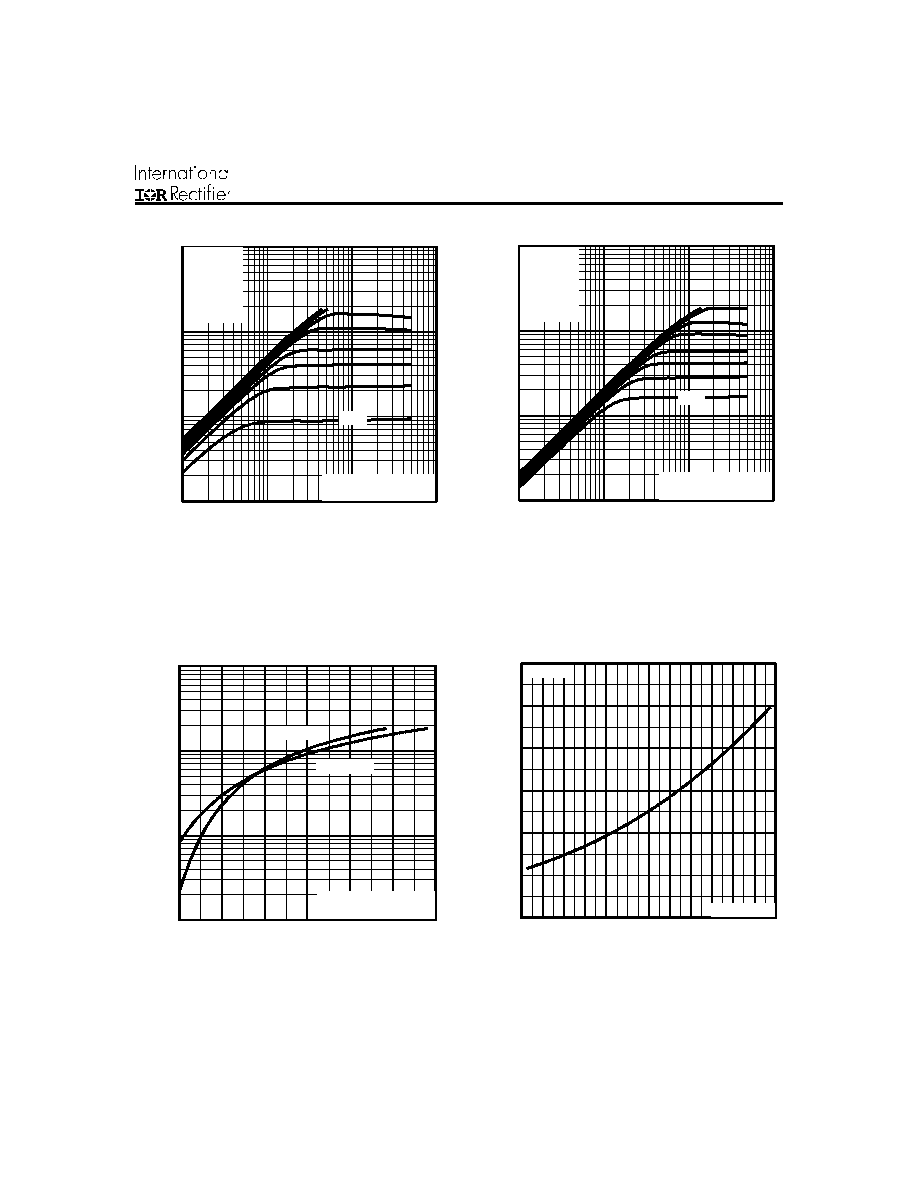
IRF3710S/L
Fig 1. Typical Output Characteristics
Fig 3. Typical Transfer Characteristics
Fig 4. Normalized On-Resistance
Vs. Temperature
Fig 2. Typical Output Characteristics
1
1 0
1 0 0
1 0 0 0
0.1
1
1 0
1 0 0
I
,
D
r
ai
n
-
t
o
-
S
ou
r
c
e Cur
r
e
nt
(
A
)
D
V , D rain -to -S ourc e V o lta ge (V )
D S
VGS
TOP 15V
10V
8.0V
7.0V
6.0V
5.5V
5.0V
BOTTOM 4.5V
20 µ s P U LS E W ID TH
T = 2 5°C
C
A
4 .5 V
1
10
100
1000
0.1
1
10
100
I
,
D
r
ain-
t
o
-
S
ou
r
c
e C
u
r
r
e
nt
(
A
)
D
V , D ra in-to-S o u rce V o lta ge (V )
D S
VGS
TOP 15V
10V
8.0V
7.0V
6.0V
5.5V
5.0V
BOTTOM 4.5V
A
4.5V
2 0µ s P U L S E W ID T H
T = 17 5°C
C
1
1 0
1 0 0
1 0 0 0
4
5
6
7
8
9
1 0
T = 2 5 °C
J
G S
V , G ate-to -S o urce V oltag e (V )
D
I
,
D
r
a
i
n
-
to
-
S
o
u
r
c
e
C
u
r
r
e
n
t
(
A
)
V = 5 0 V
2 0 µ s P UL S E W ID TH
D S
A
T = 1 7 5 °C
J
0 . 0
0 . 5
1 . 0
1 . 5
2 . 0
2 . 5
3 . 0
- 6 0
- 4 0
- 2 0
0
2 0
4 0
6 0
8 0
1 0 0 1 2 0 1 4 0 1 6 0 1 8 0
J
T , J unc tion T em perature (°C )
R
, D
r
a
i
n
-
to
-
S
o
u
r
c
e
O
n
R
e
s
i
s
t
a
n
c
e
DS
(
o
n
)
(
N
or
m
a
l
i
z
ed)
V = 1 0V
G S
A
I = 46 A
D
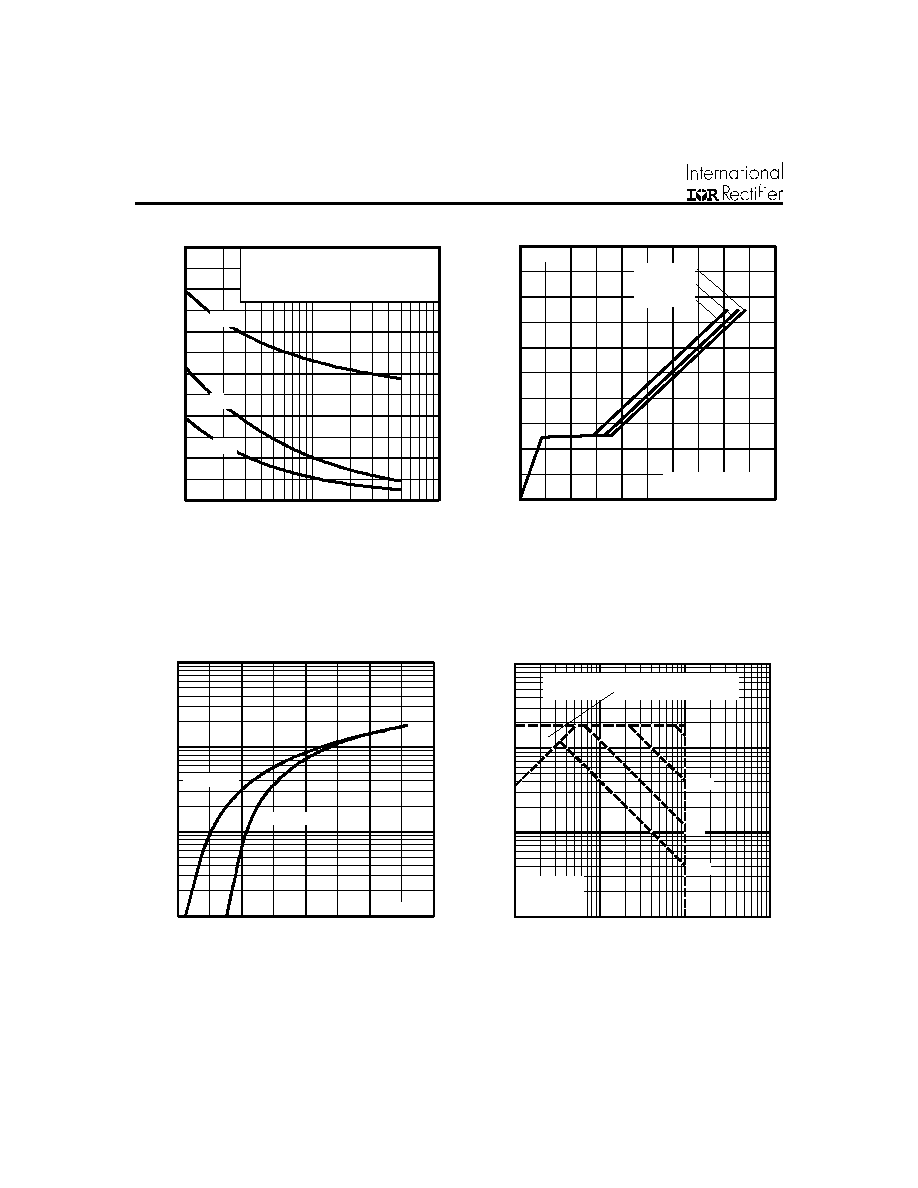
IRF3710S/L
Fig 8. Maximum Safe Operating Area
Fig 6. Typical Gate Charge Vs.
Gate-to-Source Voltage
Fig 5. Typical Capacitance Vs.
Drain-to-Source Voltage
Fig 7. Typical Source-Drain Diode
Forward Voltage
0
1 0 0 0
2 0 0 0
3 0 0 0
4 0 0 0
5 0 0 0
6 0 0 0
1
1 0
1 0 0
C
,
Cap
ac
i
t
a
n
c
e
(
p
F
)
D S
V , D rain-to-S ourc e V oltage (V )
A
V = 0V , f = 1 M H z
C = C + C , C S H O R TE D
C = C
C = C + C
G S
iss g s g d d s
rs s g d
o ss ds g d
C
is s
C
os s
C
rs s
0
4
8
1 2
1 6
2 0
0
4 0
8 0
1 2 0
1 6 0
2 0 0
Q , T otal G ate C harge (nC )
G
V
, G
a
te
-
t
o
-
S
o
u
r
c
e
V
o
l
t
a
g
e
(
V
)
GS
V = 80 V
V = 50 V
V = 20 V
D S
D S
D S
A
F O R TE S T C IR C U IT
S E E F IG U R E 1 3
I = 28 A
D
1
1 0
1 0 0
1 0 0 0
0 . 4
0 . 8
1 . 2
1 . 6
2 . 0
T = 2 5°C
J
V = 0V
G S
V , S o urc e-to -D ra in V o lta ge (V )
I , R
e
v
e
r
s
e
D
r
a
i
n
C
u
r
r
e
n
t
(
A
)
S D
SD
A
T = 17 5 °C
J
1
1 0
1 0 0
1 0 0 0
1
1 0
1 0 0
1 0 0 0
V , D ra in-to-S o u rce V o lta ge (V )
D S
I , D
r
a
i
n
C
u
r
r
e
n
t
(
A
)
O P E R A T IO N IN T H IS A R E A L IM ITE D
B Y R
D
D S (o n)
1 0 µ s
1 0 0 µ s
1 m s
1 0 m s
A
T = 25 °C
T = 17 5°C
S ing le P u ls e
C
J
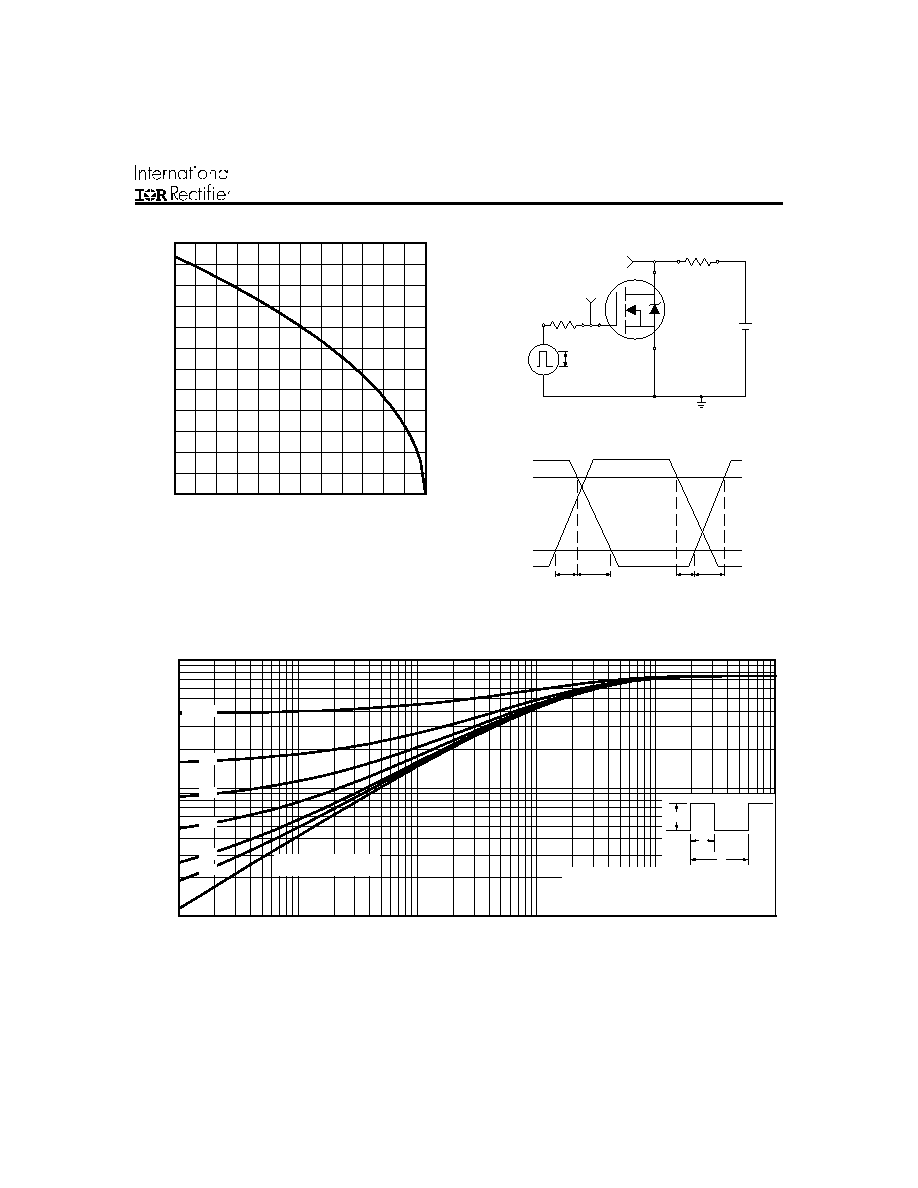
IRF3710S/L
Fig 9. Maximum Drain Current Vs.
Case Temperature
Fig 10a. Switching Time Test Circuit
V
DS
90%
10%
V
GS
t
d(on)
t
r
t
d(off)
t
f
Fig 10b. Switching Time Waveforms
V
DS
Pulse Width
1
µs
Duty Factor
0.1 %
R
D
V
GS
R
G
D.U.T.
10V
+
-
V
DD
Fig 11. Maximum Effective Transient Thermal Impedance, Junction-to-Case
0.01
0.1
1
0.00001
0.0001
0.001
0.01
0.1
1
Notes:
1. Duty factor D =
t / t
2. Peak T = P
x Z
+ T
1
2
J
DM
thJC
C
P
t
t
DM
1
2
t , Rectangular Pulse Duration (sec)
Thermal Response
(Z )
1
thJC
0.01
0.02
0.05
0.10
0.20
D = 0.50
SINGLE PULSE
(THERMAL RESPONSE)
25
50
75
100
125
150
175
0
10
20
30
40
50
60
T , Case Temperature
( C)
I , Drain Current (A)
°
C
D




